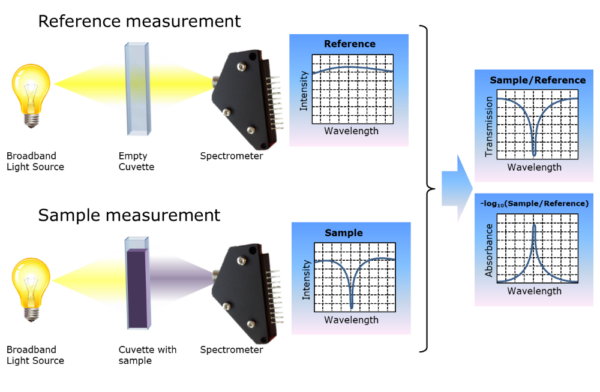Absorption spectroscopy
Absorption spectroscopy
Absorption spectroscopy works as an analytical chemistry tool that can determine if a particular substance is present in a sample and often also quantify how much of the substance is present. Near-infrared (NIR) and ultraviolet-visible (UV-VIS) spectroscopy is particularly common in these kinds of analytical applications.
There are many different approaches for measuring absorption spectra in spectrophotometry. The most common one is to point a beam of light at a sample and detect the intensity of the radiation that goes through it. The absorbance is defined as the negative of the logarithm (base 10) of the relative transmission. A 10% transmission corresponds to an absorbance of 1 absorption units (AU) and a transmission of 1% corresponds to 2 AU.
Especially for UV-VIS spectroscopy, it is common to use the Beer-Lambert Law to calculate the concentration of a particular molecule from the measured absorbance. For NIR spectroscopy however, more sophisticated software methods referred to as chemometrics have to be used.

Detectors for UV-VIS spectrometers:
The UV-detector inside a spectrophotometer for absorption spectroscopy can be implemented in three fundamentally different ways
- Fixed wavelength detector
- Tunable wavelength detector
- Full spectrum detector
Below you can read some more detailed descriptions of each.
Fixed wavelength UV-detector
A fixed wavelength detector consists of an optical bandpass filter allowing a specific wavelength (for instance 254 nm) to pass through to a silicon photo-detector. All other wavelengths than the filter wavelength are blocked. The main benefits of this solution are it’s simplicity, robustness and relatively low cost. The main drawback is that the wavelength is fixed and you can only analyse at one specific wavelength at a time. This means that this kind of solution is best suited for systems where you are going to do the same analysis on the same material over and over again – like in a production set-up in a factory. Some systems will enable you to manually exchange the filter or include several filters in the UV-detector. In any case, you are still limited to a fixed set of analysis wavelengths. For this reason, it can be hard to trouble shoot if something goes wrong – for instance if your sample is contaminated and there is absorption at a different wavelength than the one you are measuring at.
Tunable/scanning wavelength UV-detector
In a tunable wavelength detector the filtering element is a so-called grating monochromator that can be adjusted (by the instrument control software) to select the wavelength you want to use for analysis. The benefit of this is clearly that you are free to choose any analysis wavelength. However, as with the fixed wavelength filter above it can be difficult to troubleshoot when you only have data at one wavelength.
The grating monochromator can also be used to scan through the entire wavelength range for each measurement. This means you have much data which can be used to trouble shoot or analyse more complex absorption spectra with many peaks at different wavelenghts. The scanning is however fairly slow – a full scan will often take around 1 minute. Therefore, this is often not a workable method for time critical experiments.
Grating mono-chromators can offer a large absorbance grange – even up to 5 AU for the more advanced ones.
A final thing to mention about mono-chromators is that the detector has movable parts inside that can be worn out over time.
Full spectrum UV-detector
A diode array detector (often abbreviated DDA) will detect absorbance at all wavelengths in the spectrum simultaneously. This type of analysis is thus much more versatile than the two other methods because you always obtain absorbance data at all wavelengths in one “shot”. Typically, a full spectrum can be aquired in a few milliseconds. This is particularly useful if you are using your instrument for many different samples – like in development of new pharmaceuticals or Contract Research Organisation (CRO) laboratories. And, even if you are only interested in absorbance at one wavelength, having access to the full spectrum will make it much easier to trouble shoot if something goes wrong.
A DDA is also robust and compact since it doesn’t include any movable parts.
Compared to filters and mono-chromators DDA’s main drawback is that they can typically only measure absorbance levels up to 2.5 – 3 AU.
Learn more about
Want to know more?
For further information see below.